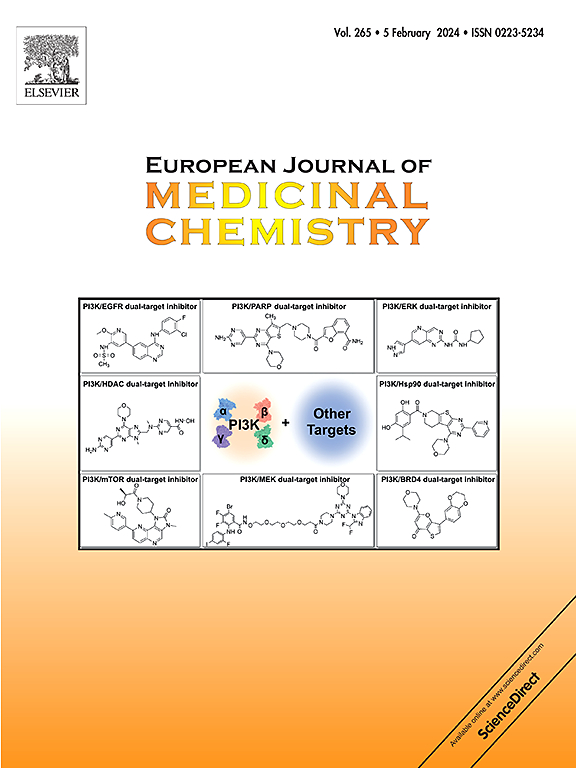N,N ' -二取代二胺在抗疟疾药物开发中的进展:构效关系及机制研究
IF 6
2区 医学
Q1 CHEMISTRY, MEDICINAL
引用次数: 0
摘要
在此之前,我们报道了30种N,N ' -二取代二胺的合成,其中一些对顶复体寄生虫,包括恶性疟原虫和刚地弓形虫具有有效的活性。在此基础上,我们用54种新化合物扩展了该系列,对相同的寄生虫进行了评估。这些类似物是通过脂肪族二胺与各种芳香醛的一锅还原胺化反应合成的。新文库显示出巨大的潜力,一些化合物对恶性疟原虫的pIC50值大于6.0,选择性指数范围(SI≥10)可接受。此外,一些化合物对弓形虫有活性,但在不同细胞内生态位生存的两种顶复合体寄生虫之间没有明显的活性相关性。进行了全面的构效关系(SAR)分析,包括先前报道的收集和新的类似物。此外,选定的击中物对耐药恶性疟原虫菌株进行了测试,显示出与敏感菌株相当的活性。为了深入了解作用机制,我们检查了寄生虫的形态变化,观察了不同化合物的不同机制。最后,我们评估了三种选定的命中物的体内活性,尽管没有观察到大量的寄生虫清除。这一结果强调了优化SAR以提高渗透性、溶解度和生物利用度的机会,或者它可能表明一种抑制寄生虫而不是杀死寄生虫的作用机制。总之,这项工作突出了N,N ' -二取代二胺在抗疟疾药物发现中的潜力。今后的工作将集中在提高体内疗效和进一步阐明作用机制上。本文章由计算机程序翻译,如有差异,请以英文原文为准。


Advancing N,N′-disubstituted diamines in antimalarial drug development: Structure-activity relationships and mechanistic studies
Previously we reported the synthesis of thirty N,N′-disubstituted diamines, several of which exhibited potent activity against apicomplexan parasites, including Plasmodium falciparum and Toxoplasma gondii. Building on this, we expanded the series with fifty-four new compounds, which were evaluated against the same parasites. These analogs were synthesized via a one-pot reductive amination of aliphatic diamines with various aromatic aldehydes. The new library showed great potential, with several compounds achieving a pIC50 greater than 6.0 against P. falciparum and with an acceptable selectivity index range (SI ≥ 10). Additionally, some compounds exhibited activity against T. gondii, although no clear correlation in activity was observed between the two apicomplexan parasites which survive in different intracellular niches. A comprehensive structure-activity relationship (SAR) analysis was performed, encompassing both the previously reported collection and the new analogs. Furthermore, selected hits were tested against resistant P. falciparum strains, demonstrating comparable activity to that observed with sensitive strains. To gain insights into the mechanism of action, we examined morphological changes in the parasite for selected hits, observing distinct alterations that suggested diverse mechanisms across the compounds. Finally, we evaluated the in vivo activity of three selected hits, though substantial parasite clearance was not observed. This outcome highlights the opportunity to optimize SAR to enhance permeability, solubility, and bioavailability, or it may suggest a parasitostatic rather than parasiticidal mechanism of action. In conclusion, this work highlights the potential of N,N′-disubstituted diamines in antimalarial drug discovery. Future efforts will focus on improving in vivo efficacy and further elucidating the mechanism of action.
求助全文
通过发布文献求助,成功后即可免费获取论文全文。
去求助
来源期刊
CiteScore
11.70
自引率
9.00%
发文量
863
审稿时长
29 days
期刊介绍:
The European Journal of Medicinal Chemistry is a global journal that publishes studies on all aspects of medicinal chemistry. It provides a medium for publication of original papers and also welcomes critical review papers.
A typical paper would report on the organic synthesis, characterization and pharmacological evaluation of compounds. Other topics of interest are drug design, QSAR, molecular modeling, drug-receptor interactions, molecular aspects of drug metabolism, prodrug synthesis and drug targeting. The journal expects manuscripts to present the rational for a study, provide insight into the design of compounds or understanding of mechanism, or clarify the targets.

 求助内容:
求助内容: 应助结果提醒方式:
应助结果提醒方式:


